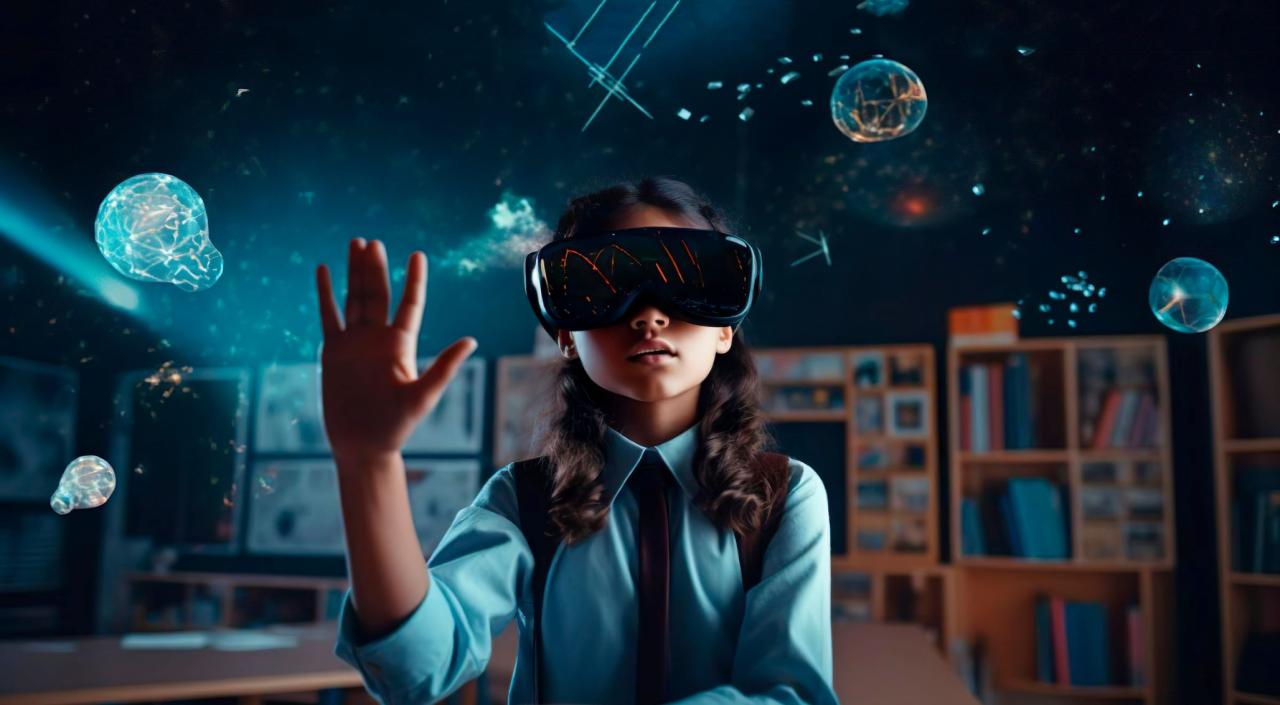The Next Frontier in Education: How Generative AI and XR Will Evolve the World of Learning in the Next Decade
Rhea-AI Summary
Qualcomm's Elliott Levine envisions the future of education through generative AI and extended reality (XR). The concept of '(Ai)Daptive XR' combines AI with spatial computing to create immersive, personalized learning environments. This technology could revolutionize education by:
1. Adapting to students' current abilities and language preferences
2. Delivering true personalization based on strengths and weaknesses
3. Making learning relevant by adjusting content to students' interests
4. Providing real-time feedback and natural assessments
5. Enabling collaborative learning experiences
While K-12 education in the US is a $100+ billion industry, only 4% is invested in education technology. (Ai)Daptive XR could significantly improve academic outcomes by offering active teaching methods and addressing individual student needs.
Positive
- Qualcomm is positioned at the forefront of AI and XR processing technology
- The concept of (Ai)Daptive XR could revolutionize personalized learning
- Potential for significant improvement in academic outcomes through active teaching methods
Negative
- Only 4% of the $100+ billion K-12 education industry is currently invested in education technology
- Implementation of (Ai)Daptive XR may require addressing governance, privacy, connectivity, and equity issues
News Market Reaction 1 Alert
On the day this news was published, QCOM gained 0.70%, reflecting a mild positive market reaction.
Data tracked by StockTitan Argus on the day of publication.
(Ai)Daptive XR empowers students through real-time personalization and collaborative learning
NORTHAMPTON, MA / ACCESSWIRE / July 16, 2024 / Qualcomm

Written by Elliott Levine
Envisioning the future of education, and the art of learning overall, is nothing new. Over 120 years ago, French artist Jean-Marc Côté suggested how learning may look in the year 2000. While many looked at his image and chuckled - the idea that books may be somehow processed and electronically uploaded directly to the minds of young people - the concept would be re-introduced in the 1999 science fiction movie "The Matrix."
But can life imitate art? Will artificial intelligence (AI) and extended reality (XR) converge in the coming years to reflect the learning environments depicted by Côté and "The Matrix"?
In the United Sates of America, K-12 education represents a
Extended reality (XR) also known as spatial computing, is the spectrum of immersive experiences that blend the physical and virtual space and are accessible through a head-worn device such as glasses or headset.
Today, most educational XR experiences focus on games, virtual tours, and immersive and experiential experiences that enable real-world applications of theory learning in the classroom. But with the convergence of AI capabilities, we are on the verge of a true transformational opportunity to live up to the promise of real "personalized" learning in ways that can deliver measurable academic results. The coming years will allow us to see these various generative AI applications in use today, automating them to deliver real-time learning experiences.
What is possible with generative AI in classrooms today?
Teachers can leverage generative AI to create highly customized lessons. In a series of manual steps, educators can quickly create dynamic videos to serve as instructional tools with little-to-no technical skills. Let's outline one such path in which such content can be created:
Write base script: Ask Bard or ChatGPT to write you a short three- to five-minute video script about the instructional topic or challenge you wish to address. Adjust any content to address measurable learning goals.
Transform to conversational script: Paste the initial text into a tool like Quillbot to paraphrase the content created initially by AI so it comes across as more genuine and conversational in tone.
Create your audio narration: Paste the new conversational text into a tool such as Speechify. With their premium subscription, you'll have a host of voices including Snoop Dogg and Gwenyth Paltrow to choose from.
Create your video: Use Movio or Invideo to turn an audio script into a video. You can pick the genre and delivery format.
Using this method and many other avenues like it, educators are empowered to take their custom lessons a step further with personalization. For example, generative AI can create lesson plans that amplify a student's strengths, while also addressing areas that need improvement. Large language models can be trained to have conversations with students for specific, on-demand support, which in turn can free up time for teachers.
But while modern technology has certainly brought education into the present day, we mostly see this in the form of tablet and computer screens. While current 2D technology takes on a form that is familiar with students today, they still end up looking at screens instead of interacting with their instructors and fellow classmates. This is where XR comes into play and seeks to address this disconnect. Another possibility with generative AI in education is combining it with the power of spatial computing to create an immersive learning environment that engages learners with interactive and collaborative lessons.
Artificial intelligence (AI) is a term that encompasses a variety of technologies that give the ability to computer programs to execute tasks that are commonly associated with human intelligence.
Applying the AI approach to XR learning
Today, most XR learning experiences exist as simulations (i.e., the reproduction of an environment, scene or exercise in a three dimensional and virtual environment, or walk-throughs, an elevation of typical videos and manipulatives used in labs and classrooms). They are mostly individual experiences with a clear beginning and completion. And even with XR learning as it exists today, a PwC report found that learners mastered content four times faster than traditional classroom learning, and users were nearly three times more confident to apply the skills learned from their XR training.3
What if we applied the best of generative AI into a real-time platform? The result, I believe, is a transformational tool that allows every learner to achieve their greatest potential. Let's look at just some of the ways this concept of (Ai)daptive XR (pronounced Ay-daptive) can deliver meaningful results:
Introduces learning where the student is currently at: (Ai)daptive XR works with the reality of that student's ability. If they are more comfortable learning in an alternate language, then content is immediately delivered in that language (overcoming a typical obstacle for English Second Language learners today).
Personalization: While today's efforts at personalization are often no more than differentiated learning, (Ai)daptive XR can deliver true personalization. In a matter of moments, from typically the first few challenges in a immersive experience, the tool can recognize strengths and weaknesses, as well as adjust the learning objectives. For example, if the simulation's goal is to measure volume of spaces, yet the learner struggles with complex multiplication, the learner would typically fail the simulation with little progress. (Ai)daptive XR can quickly assess the root cause of the gap - and alter the learning objectives to help the child meet the necessary prerequisites to accomplishing the original learning goal. A new XR experience is created based on the learning challenges identified. Subsequently, the learner can then be better prepared to successfully complete the objectives, rather than allow these deficiencies to gain momentum and cause the child to fail academically later.
Making learning relevant: A reason most classroom topics fail to "engage" students is that they fail to see the relevance of the subject matter. However, by understanding the personal passion of a student, (Ai)daptive XR content can be quickly adjusted to present the subject matter in a theme that is both relevant and effective to the student. For example, a simulation measuring area of farmland could quickly be updated in real-time to measuring area of fabric for a young person who daydreams of being a fashion designer. That quick change can have significant changes to the outcome of that simulation.
Responsive to User: Rather than merely assessing performance by where one "clicks" with a hand controller, (Ai)daptive XR can respond to vocal feedback from the user(s) in their native language. Whereas today's XR experiences have limited ability to collect user feedback, accepting conversational speech from the user will allow for more natural interaction and help the system appropriately address questions or concerns.
Real-Time Feedback: Not only do virtual and augmented reality experiences enable the learner to see the actual implications for their choices, but it provides an opportunity to reinforce mastery of earlier topics. In traditional classroom settings, teachers often lack ample time to conduct assessments for their students. But with XR, real-time natural assessments can be conducted multiple times daily in a stress-free environment.
Collaboration: Few XR learning experiences allow for multiple students to work together on a challenge, as it is easier to create individual-based content. (Ai)daptive XR can assess challenges and new scenarios introduced by the collaborative group of students, changing the content delivered in response to their collective actions in the simulation.
The possibilities are endless for (Ai)daptive XR
The evolution of instructional XR with AI will be a wonderful and welcome addition to EdTech in the coming decade. It represents an opportunity to deliver true personalized instruction for every child in every community. Such changes will require thoughtful discussions across many areas including governance, privacy, connectivity and equity.
As we continue to see examples of generative AI make its way into mainstream adoption over this next decade, the infusion of AI into our daily lives will become commonplace. Qualcomm Technologies stands at the crossroads of this sector, given its leadership in both AI and XR processing. It is my dream to see this evolve from concept to reality during my lifetime.
Editor's Note: This blog was edited for clarity on May 20, 2024.
Opinions expressed in the content posted here are the personal opinions of the original authors, and do not necessarily reflect those of Qualcomm Incorporated or its subsidiaries ("Qualcomm"). The content is provided for informational purposes only and is not meant to be an endorsement or representation by Qualcomm or any other party. This site may also provide links or references to non-Qualcomm sites and resources. Qualcomm makes no representations, warranties, or other commitments whatsoever about any non-Qualcomm sites or third-party resources that may be referenced, accessible from, or linked to this site.
References:
1: Allied Market Research. (Nov 10, 2023). K12 Education Market to Reach
2: HolonIQ. (January 2021). Education Technology in 10 Charts. Retrieved on May 20, 2024 from: https://www.holoniq.com/edtech-in-10-charts#:~:text=5.,term%20in%20new%20digital%20models
3: PwC. (Sep 15, 2022). What does virtual reality and the metaverse mean for training? Retrieved on May 9, 2024 from: https://www.pwc.com/us/en/tech-effect/emerging-tech/virtual-reality-study.html.
View additional multimedia and more ESG storytelling from Qualcomm on 3blmedia.com.
Contact Info:
Spokesperson: Qualcomm
Website: https://www.3blmedia.com/profiles/qualcomm
Email: info@3blmedia.com
SOURCE: Qualcomm
View the original press release on accesswire.com








